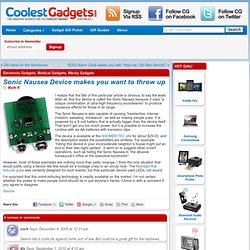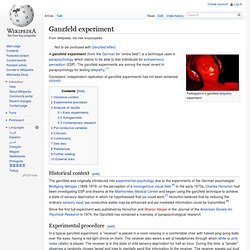

Nootropic. Nootropics (/noʊ.əˈtrɒpɨks/ noh-ə-TROP-iks), also referred to as smart drugs, memory enhancers, neuro enhancers, cognitive enhancers, and intelligence enhancers, are drugs, supplements, nutraceuticals, and functional foods that improve one or more aspects of mental function, such as working memory, motivation, and attention.[1][2] The word nootropic was coined in 1972 by the Romanian Dr.

Corneliu E. Giurgea,[3][4] derived from the Greek words νους nous, or "mind", and τρέπειν trepein meaning to bend or turn.[5] Availability and prevalence[edit] At present, there are only a few drugs which have been shown to improve some aspect of cognition in medical reviews. Nutrex Hawaii BioAstin Natural Astaxanthin 4mgs., 120 gel caps: Health & Personal Care. Good Will Hunting - "Idiosyncrasies" Sonic Nausea Device makes you want to throw up. By Mark R I realize that the title of this particular article is obvious, to say the least.

After all, this tiny device is called the Sonic Nausea because it uses “a unique combination of ultra-high frequency soundwaves” to produce nauseous effects for those in its range. The Sonic Nausea is also capable of causing “headaches, intense irritation, sweating, imbalance”, as well as making people puke. It is powered by a 9-volt battery that is actually bigger than the device itself. That won’t get you too much power, but it is possible to increase the runtime with six AA batteries with transistor clips. The device is available at the SHOMER-TEC site for about $29.00, and the description states the possibilities are endless. However, most of these examples are nothing more than petty revenge. I’m surprised that this vomit-inducing technology is readily available on the market.
Source. Trip Glasses let you meditate and hallucinate in style. By Ally Most people meditate to get away from the fast paced world and even technology.

Well for those of you that can’t stand to be without your technology and would like to have a little more fun while you’re meditating, Think Geek has you covered. With this you’ll get to have the Woodstock experience without all of those harmful drugs. It’s the way true geeks relax after a long hard day in front of the computer. You just sit with your eyes gently closed and the headset as well as the glasses on. Source: Crunchgear. Ganzfeld experiment. Participant in a ganzfeld telepathy experiment A ganzfeld experiment (from the German for “entire field”) is a technique used in parapsychology which claims to be able to test individuals for extrasensory perception (ESP).

The ganzfeld experiments are among the most recent in parapsychology for testing telepathy.[1] Consistent, independent replication of ganzfeld experiments has not been achieved.[2][3][4][5] Historical context[edit] Since the first full experiment was published by Honorton and Sharon Harper in the Journal of the American Society for Psychical Research in 1974, the Ganzfeld has remained a mainstay of parapsychological research. Experimental procedure[edit] In a typical ganzfeld experiment, a "receiver" is placed in a room relaxing in a comfortable chair with halved ping-pong balls over the eyes, having a red light shone on them. Analysis of results[edit] Early experiments[edit] Autoganzfeld[edit] Ray Hyman in 1983 with Lee Ross, Daryl Bem and Victor Benassi. Nootropyl piracetam: Health & Personal Care.
Piracetam. Piracetam (sold under many brand names) is a medication in the racetams group, with chemical name 2-oxo-1-pyrrolidine acetamide.

It is approved in the United Kingdom[2] but is not approved in the United States.[3][4] In the UK, piracetam is prescribed mainly for myoclonus,[5] but is used off-label for other conditions. Evidence to support its use for many conditions is unclear, although it is marketed as a nootropic (cognitive enhancer). Studies of piracetam's cognitive effects have had equivocal results, sometimes showing modest benefits in specific populations and sometimes showing minimal or no benefit.[6] It shares the same 2-oxo-pyrrolidone base structure with pyroglutamic acid.
L-tyrosine & Piracetam. L-tyrosine and piracetam are both compounds that serve as dietary supplements.

While they each play a role in brain function, L-tyrosine is a naturally occurring molecule found in proteins, and piracetam is a synthetic drug belonging to a class called nootropics, or smart drugs. These compounds can help improve certain cognitive functions and appear to have little risk of toxicity. However, consult your health care provider before adding either L-tyrosine or piracetam supplements to your health regimen. L-tyrosine is an amino acid, or protein building block. Because your body can synthesize it from another amino acid called phenylalanine, you do not require it in your diet unless your diet lacks phenylalanine.
L-tyrosine is a safe supplement for most people. Belgian researchers first synthesized piracetam in the 1960s. Although many cognitive function studies with piracetam look promising, several studies show inconclusive data, according to The Cochran Library.